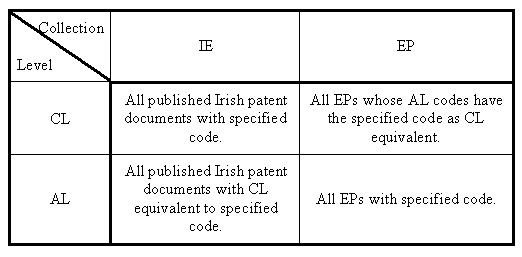|
|
A62C
8/00 |
Hand tools or accessories specially adapted for
fire-fighting, e.g. tool boxes
|
|
A62C
8/02 |
.
Buckets
or pails |
|
A62C
8/04 |
.
Rakes
or beaters |
|
A62C
8/06 |
.
Fire-blankets |
|
A62C
8/08 |
.
Shields |
A62C
8/00 is an IPC CL place for technical matter related to
fire-fighting accessories. IPC
AL also contains this place, but with 4 subdivisions. So a
fire-fighting hand-shield or shield accessory would be AL classified
in A62C 8/08, whereas the equivalent CL classification is A62C 8/00.
Indeed, in the AL, only fire-fighting hand tool or
accessories not relating to buckets, pails, rakes, beaters,
fire-blankets or shields would go in A62C 8/00, whereas all relevant
technologies go to A62C 8/00 in the CL, which is the formal CL
equivalent for any of AL A62C 8/00–08.
In
theory, an AL classification should give rise to a specific CL
classification. In
practice, however, a small number of discrepancies between the two
levels exist, partly because of the difference in the revision
cycles for the two levels, and partly due to the operation of
precedence notes and references in the AL which are not visible to
CL users. Hence,
mismatches do occur between the intellectually applied CL
classification for a patent and the automated CL code generated from
an applied AL classification.
Using
the IPC to search the patent database.
The IPC search query module consists of two entry fields, one each for CL and AL codes. Associated with each entry field are two tick boxes, for designating IE or EP in respect of a given code.

Since
there are two types of patent valid in Ireland, each classified
according to different levels of the IPC, this search engine allows
the user to search the two parts of the national collection
separately or in combination. The
user can also choose for either patent type independently which
level of the IPC to use. The following table summarises the results to be expected for
each selection.

Since
both types of patent carry CL classifications, both sets can be
searched directly using the IPC CL.
Please note, however, that whereas a CL search of IEs will
return hits from Irish patents with CL classifications as applied by
the Irish Patent Office, the same search for EPs will return EPs
whose automated CL classification set contains the code
specified.
An
EP AL search will return patents with the specified code as applied
by the EPO. Though IE
patents do not formally carry Advanced level classifications, a
search of IEs will return any patent with the formal CL equivalent.
This will of course create a certain amount of “noise”,
since the equivalent CL place to a given AL place is generally
somewhat broader in scope. However,
the volume of Irish national documents is considerably less than for
EP designates, so this is not such a problem.
Users may also combine CL and AL searches. For instance, specifying a code in each entry field, the user may select IE at Core level and EP at Advanced level. This strategy ensures that the user is searching according to classification codes applied by examiners according to strict IPC usage, and avoids the problem of discrepancies between intellectual and automated CL assignations.